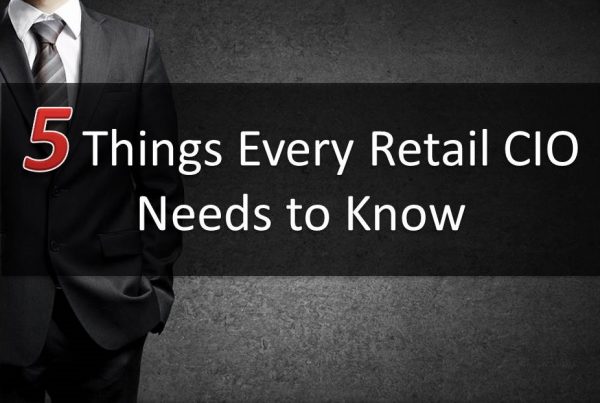The Future is Digital
Becoming digital is the surest way for you to understand your customers' needs and meet their expectations. Learn how Perficient can help anticipate what's ahead for you and your customer with a digital strategy centered around empathy, alignment, and agility.
We know it’s a new year when the NRF Big Show kicks off in January. Each year we migrate to New York City to see the best and brightest of retail for the next year. This year is no exception – and like the holiday shopping season just passed, we go looking for the new shiny presents (ideas) available to us to help push our organizations closer to our ultimate goals.

So, what are retail executives looking for this year? What shiny new presents should we be exploring to help us reach our customers, operate more effectively, and do it securely and cost-effectively, so that we don’t end up with “breaches” as have most recently been in the news?
The NRF has a CIO Council. This council by all accounts has both experience and talent, with over 1,000 years of collective experience. At NRF, Retail CIOs shared the top 5 things IT organizations are looking for going into this new year, all buzz-words, and shiny new objects aside:
1. Meeting omni-channel (or insert next buzzword here) expectations.
Well, maybe not omni-channel, as there is general agreement that this has become the most commonly over-used buzzword in the industry. Some companies embrace omni-channel, as they have created issues for themselves by treating their on-line customers differently from their in-store, bricks and mortar customers. Others despise the word omni-channel, as they have never created the schism between on-line, and in-store. What everyone does agree to is the notion that they need to give customers what they expect in a seamless, unified manner as part of the overall customer experience. The notion for this year is still omni-channel in retail.
Leading companies must look at the entire customer journey, and try to positively engage and serve their customers at every step in their journeys – regardless of whether it a digital or physical experience.
2. The CIO’s search for the Holy Grail continues.
There is still no one “platform” for retail. Elements of critical functionality are still found in disparate systems – ecommerce, POS, order management/ERP – no one has completely pulled together a “secret sauce” that covers all of the critical functionality needed to run a retail business. And, with technology mega-shifts are happening – especially with consumers now having more savvy technology in their hands than the average Joe inside a retailer, it will likely continue to be this way.
As a result, the number one IT capability and skill set that most retailers still need, and actively seek will be “integration” capabilities. If the providers out there will not pull technology together under one platform or schema, then integration will continue to be the key skill set for every retailer to bring to make ends meet well into the foreseeable future.
3. Is finding the Holy Grail the real issue anyway for CIOs?
Despite the fact that there is not a “unified IT/Application Platform” – this is still not the real issue. Business process change and change management – the soft stuff – is still the number one challenge that holds most retailers back from fully using their own, and consumer’s technology more effectively. There is still a lot of “well, that’s not how we do things here” kinds of thinking going on that will limit how far and quickly retailers can move into the new digital/physical retail world. This implies that the power shift that’s taken place – the consumer is in charge now – has still not taken hold in companies as well as it should.
Companies and every retail employee must go back to the old adage of Sam Walton, who said, “There is only one boss. The customer. And he can fire everybody in the company from the chairman on down, simply by spending his money somewhere else.” But, as we all know, this is even more true today, spending their money elsewhere is happening at light speed. So, it’s important for not just IT people to understand this digitally-enabled customer, but everyone, especially the leaders in the company.
4. Retailers don’t yet have all the answers for mobile.
Yes! Mobile will continue be one of the key focal points with the customer experience for online shopping. Many consumers are already mobile-enabled, just not using your particular flavor that portrays you in a way you wish to be portrayed. Therefore, your consumers are being led elsewhere by others – mostly likely not looking out for your best interests, nor your customers’ in many cases.
The key for mobile is to first “be there”. As part of this, retailers are testing use cases and experimenting with what works for their consumers. But, of course it needs to go beyond just being there, and giving them the kind of experience that they expect. The well-said objective stated was to make the mobile applications “wildly useful” to your customers.
5. CIOs need to collaborate on customer experience.
We all say this, I think, that customer experience will be the key differentiator of the future. We also know that the melding of the physical and digital world will be a big part of the overall customer experience going forward. But, now the question arises: “who owns the customer experience?” After all, assigning ownership gets stuff done, right? Perhaps sometime in the future, every retailer will have a “Chief Customer Officer” – the one person who is responsible for the collective customer experience. But, more likely, the answer is not in one person, or organization, but is a team approach. The team is made up of all of those who have direct, or indirect impact on the overall customer experience – isn’t that every organization in the company?
Ah, perhaps it starts with those who do directly come into contact with customers every day – after all it is about knowing the customer that is important, right? In yesterday’s world this was primarily stores, but then many retailers added digital channels – so, we add the e-commerce folks, oh, and customer service is now becoming more strategic, and finally, marketing who is getting the most unprecedented access to consumers they have ever had. Each of these departments, and supporting divisions, continue to play a role – merchandising, supply chain, finance – are undergoing potentially massive changes in how they do business. But, again, the subject is not their function, or how they’ve done things, or even how they’d like to do things, but again, gaining those deep insights, deep relationships, deep ability to “serve” their customers.
